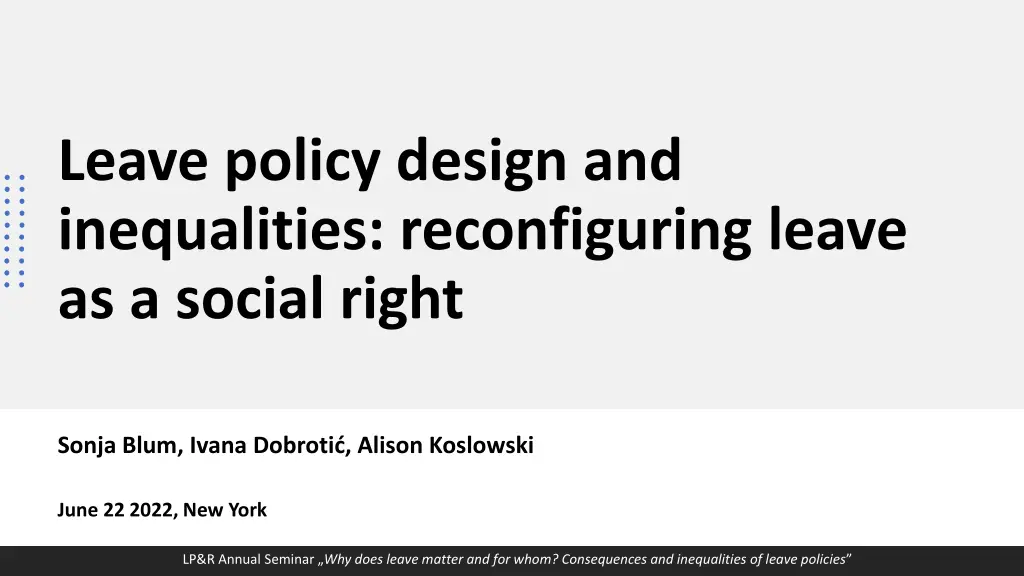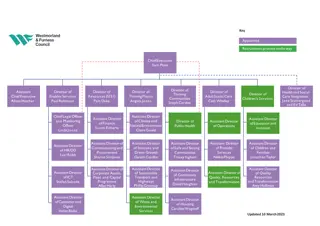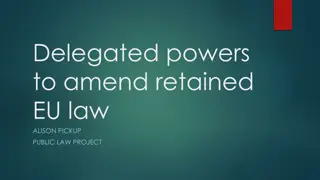
Leave Policy Design and Inequalities: Social Rights Focus
Explore the societal impact of leave policies and the inequalities they present in this insightful seminar, delving into the inclusiveness of parenting leave rights and the origins of such policies. Gain valuable insights on the consequences and disparities in access to leave rights. Discover more on the evolving landscape of leave policy design and eligibility criteria.
Download Presentation

Please find below an Image/Link to download the presentation.
The content on the website is provided AS IS for your information and personal use only. It may not be sold, licensed, or shared on other websites without obtaining consent from the author. If you encounter any issues during the download, it is possible that the publisher has removed the file from their server.
You are allowed to download the files provided on this website for personal or commercial use, subject to the condition that they are used lawfully. All files are the property of their respective owners.
The content on the website is provided AS IS for your information and personal use only. It may not be sold, licensed, or shared on other websites without obtaining consent from the author.
E N D
Presentation Transcript
Leave policy design and inequalities: reconfiguring leave as a social right Sonja Blum, Ivana Dobroti , Alison Koslowski June 22 2022, New York LP&R Annual Seminar Why does leave matter and for whom? Consequences and inequalities of leave policies
Out December 2022 Flyer available! - https://www.e-elgar.com/shop/gbp/research- handbook-on-leave-policy-9781800372207.html Concluding chapter (chapter 28): What have we learned? LP&R Annual Seminar Why does leave matter and for whom? Consequences and inequalities of leave policies
How inclusive are parenting leave rights? Inequalities forms a common thread through the handbook Who is excluded due to not fulfilling eligibility criteria? employment type or history, citizenship, other personal characteristics, household constellation Recently, these long-neglected questions have been put centre stage in leave policy research (see, e.g., McKay et al., 2016; Dobroti & Blum,2019, 2020; O Brien et al., 2020; Blum & Dobroti , 2021; Kurowska, 2021; Son & B ger, 2021; Whitehouse & Nakazato, 2021) Questions of eligibility and broader social inequalities in access to leave rights complement other, more longstanding foci on gender inequalities in leave policy research LP&R Annual Seminar Why does leave matter and for whom? Consequences and inequalities of leave policies
Origins of leave policies A milestone for leave development set by the 1919 Maternity Protection Convention by the International Labour Organisation (ILO) (O Brien & Uzunalioglu, Chapter 6) Focus on fathers dominant streams of research (Deven & Moss, Chapter 2) Other leaves are called for to cater for an increasingly diverse range of events in an individual s life course (Baird et al., Chapter 26) Global variation LP&R Annual Seminar Why does leave matter and for whom? Consequences and inequalities of leave policies
Leave policy design and inequalities in eligibility Leave policies are usually part of a country s social security architecture, and so where such architecture is minimal or narrow in terms of its reach inequalities in eligibility are at their greatest Parenthood as (an old and/or new) social risk Social rights may be available universally for all affected by a specific social risk, or eligibility may be selective, restricted to certain groups (e.g., only employees) or conditions (e.g., excluding those with short-term contracts) (Blum & Dobroti , 2021, 223) The questions that come to the fore through the social-rights perspective and Dobroti & Blum s (2019, 2020) focus on inclusiveness: who is granted access to leaves and leave benefits and under which conditions LP&R Annual Seminar Why does leave matter and for whom? Consequences and inequalities of leave policies
Gender Gender inequalities and access to leave rights have by far received the most attention Issues of care and gender have featured prominently in comparative family policy and welfare regime analysis since the 1990s (see Ciccia, Chapter 3; Kurowska, Chapter 4) Ciccia (Chapter 3) concisely summarises the research history from a gender perspective, pointing out that we have witnessed a narrowing of the perspective from a focus on care in the welfare state (see, e.g., Lewis, 1992), over childcare regimes and varieties of familialism (see, e.g., Leitner, 2003; Szelewa & Polakowski, 2008), to the design of single policy instruments LP&R Annual Seminar Why does leave matter and for whom? Consequences and inequalities of leave policies
Household conditions Family or household related eligibility conditions (O Brien et al., 2020) have received increasing attention; the related categories which can influence inequalities in access to leave rights include, for example, LGBTIQ+ parents, single parents, separated parents, or adoptive parents Kaufman et al. (Chapter 23) compares the availability of parenting leaves for same-sex parents in six countries, illuminating differences according to the different routes to parenthood (giving birth, adoption, surrogacy) Jou et al. s (2020) study comparing the duration of paid leave available to parents in single- mother, single-father and two-parent households in 34 OECD countries, again shows the unfavourable position of some modern families compared to two-parent households LP&R Annual Seminar Why does leave matter and for whom? Consequences and inequalities of leave policies
Socio-economic conditions Investigating socioeconomic inequalities in access to leave rights is a relatively recent research line; building on work such as O Brien (2009), pioneers were McKay, Mathieu & Doucet (2016): Among workers, the question of which parents are included and excluded needs to consider age, gender, education, family composition, race (including new immigrants), indigenous parents, and employment status (type of work arrangement, sector, tenure, permanency, wage earners versus self-employed) (ibid, 558). Picking up on this call, Dobroti & Blum (2020) investigated shifts in statutory leave entitlements for 21 European countries LP&R Annual Seminar Why does leave matter and for whom? Consequences and inequalities of leave policies
Global perspectives The issue of ineligibility along socioeconomic or employment status is additionally accentuated in countries characterised by strong informal economies (see Marzonetto & Martinez-Franzoni, Chapter 21; Son, Chapter 22) When extending the view beyond Western welfare states, the dimensions of unequal access are on the one hand the same as in the sections discussed before (gender, household conditions, race/ethnicity, socioeconomic conditions), yet they show new contexts and origins of unequal access (e.g., colonialism, the significance of lacking policy enforcement, or the extent of informal labour going along with a lack of social rights) LP&R Annual Seminar Why does leave matter and for whom? Consequences and inequalities of leave policies
Reconfiguring leave as a social right? Inequalities are deeply embedded in leave policy design and also in their implementation Need to focus on the right to receive care , taking into account the child s perspective or the perspective of another person in need of care More fundamental proposals have argued for the reconfiguration of leave as a social right (e.g. Doucet 2021) LP&R Annual Seminar Why does leave matter and for whom? Consequences and inequalities of leave policies
Conclusions: a parenting leave research agenda for the next decade To deepen a more global perspective (see Son & B ger, 2021) and analysis of non- Western cases Inequalities and leave policy inclusiveness We should engage more with intersectional inequalities (e.g., Dobroti , 2022 in JESP) Investigating the politics of leave policies and their explanatory factors Child focus LP&R Annual Seminar Why does leave matter and for whom? Consequences and inequalities of leave policies






















